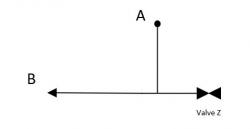Thanks Breizh. It seems that Crane does not take the radius of the inner surface into account. I compared these values with Idelchik (3rd Ed), but even though I have an English translation it is VERY difficult to read. On page 438 (Diag 7-10) Idelchik gives K values for tees with sharp corners (same as the Crane diagram). The value is 1.86 for the case of flow from the branch to only one side of the run, and with all diameters equal. This is quite close to the Crane value of 1.7
On page 462 (Diag 7-23 No. 4) Idelchik has tees with radiused corners - the translator calls these "wyes of improved shape". For r/D (corner radius / pipe diameter) of 0.22 Idelchick gives a K value of 0.8 and for r/D of 0.07 the K value is 1.0. From these values the radius is important in the determination of the K value, and this certainly reflects my own experience.
These values give me reassurance in the Darby 3K method that I used in AioFlo. For a sharp cornered 1" tee and a velocity of 1 m/s the 3K method gives a K value of 1.7 - in line with the Crane value. But if we go to a typical forged or cast tee with radiused corners - and using 2 m/s in a 8" pipe - AioFlo gives a K value of 1.06.
These differences will not have a large impact in practice, but they do highlight the improved performance of more modern methods like 3K.

 FB
FB













